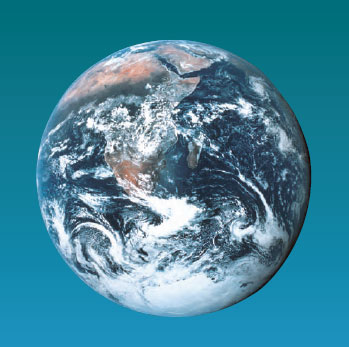The Biosphere and Animal Distribution
 |
| Spaceship earth. |
All life is confined to a thin veneer of the earth called the biosphere. From the first remarkable photographs of earth taken from the Apollo spacecraft, revealing a beautiful blue and white globe lying against the limitless backdrop of space, viewers were struck and perhaps humbled by our isolation and insignificance in the enormity of the universe. The phrase “spaceship earth” became a part of our vocabulary, and the realization evolved that all the resources we will ever have for sustaining life are restricted to a thin layer of land and sea and a narrow veil of atmosphere above it. We could better appreciate just how thin the biosphere is if we could shrink the earth and all of its dimensions to a 1 m sphere. We would no longer perceive vertical dimensions on the earth’s surface. The highest mountains would fail to penetrate a thin coat of paint applied to our shrunken earth; a fingernail’s scratch on the surface would exceed the depth of the ocean’s deepest trenches.
Earth’s biosphere and the organisms in it have evolved together. In the continuous interchange between organism and environment, both have been altered, and a favorable relationship preserved. Earth’s biosphere, with its living and nonliving components, is not a static thing but has undergone an evolution in every way as dramatic as the evolution of the animal kingdom. Today the biosphere is changing rapidly under the impact of humans, one of the greatest agents of biotic disturbance the earth has ever known. Only the historical bombardment of the earth by asteroids has produced a greater disturbance of the earth’s biota.
 |
| Figure 39-1 Changing composition of earth’s atmosphere over time. The primitive atmosphere formed as hydrogen, methane, and ammonia. Hydrogen, too light to be held by the earth’s gravitational field, was lost to space. Nitrogen, carbon dioxide, sulfur dioxide, and water vapor emitted from volcanoes replaced the remaining primitive gases. The first free oxygen was formed by solar radiation acting on water molecules (photochemical dissociation) in the atmosphere. When oxygen-producing plants appeared 3 to 3.5 billion years ago atmospheric oxygen gradually rose to its present level approximately 400 million years ago. |
In a universe of billions of stars, our earth is a small planet circling an ordinary star. Thousands of other stars are like our sun with planetary systems that conceivably could support life. Yet, of all these, our planet is the only one that we know supports life. Until proven otherwise, the earth is unique, a true wonder of an infinite universe.
What makes earth an especially fit environment for life? Most biologists would agree that foremost is the presence of liquid water on the earth’s surface. Water, with its many extraordinary physical properties provided the medium for the origin of life and bestowed on earth a moderate climate suitable for life’s continued evolution. Many other properties of earth make it optimal for life. Among these are a steady supply of light and heat from an unfailing sun; a suitable range of temperature for life, neither too hot nor too cold; a supply of the major and minor elements required by living matter; and a gravity force strong enough to hold an extensive gaseous atmosphere.
An organism and its environment share a reciprocal relationship. The environment is modified by organisms, and populations of organisms are modified by the evolutionary process to adapt them to the environment and its changes. As an open system, an animal is forever receiving and giving off materials and energy. Building materials for life are obtained from the physical environment, either directly by producers such as green plants or indirectly by consumers that return inorganic substances to the environment by excretion or by decay and disintegration of their bodies.
A living form is a transient link that is built of environmental materials, which are then returned to the environment to be used again in the recreation of new life. Life, death, decay, and re-creation have been the cycle of existence since life began.
The primitive earth of 4.5 billion years ago, barren, stormy, and volcanic with a reducing atmosphere of ammonia, methane, and water (Figure 39-1), was wonderfully fit for the prebiotic syntheses that led to life’s beginnings. Yet, it was totally unsuited, indeed lethal, for the kinds of living organisms that inhabit the earth today, just as early forms of life could not survive in our present environment. The appearance of free oxygen in the atmosphere, produced largely if not almost entirely by life, is an example of the reciprocity between organism and environment. Although oxygen was at first poisonous to early forms of life, its gradual accumulation from photosynthesis over the ages forced protective biochemical alterations to appear that led eventually to complete dependence on oxygen by most organisms. As living organisms adapt and evolve, they act on and produce changes in their environment. In so doing they must themselves change.




